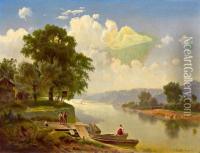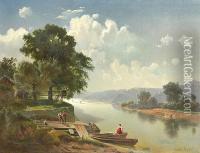Adalbert Vojtech Brechler Paintings
Adalbert Vojtech Brechler, born in 1907 in what was then Austro-Hungarian Empire and later became Czechoslovakia, is a figure whose contributions to the art world, though not widely recognized in the mainstream art historical narrative, hold significance within specific circles, particularly those interested in the interwar and post-World War II European art scenes. Brechler's early life was marked by the upheavals of World War I and the subsequent political transformations in Central Europe, experiences that would later influence his artistic endeavors.
Brechler's education in art began in the 1920s, a vibrant period for the arts in Europe, with movements such as Expressionism, Dadaism, and Surrealism gaining momentum. He was particularly drawn to the innovative approaches to form and color, which would become hallmarks of his own work. By the 1930s, Brechler had established himself within certain art circles, yet the advent of World War II and the occupation of Czechoslovakia by Nazi Germany profoundly impacted his career and personal life.
During the post-war period, Brechler's style evolved, reflecting the somber realities of the time. His work from this era is characterized by a more subdued palette and a focus on themes of loss, resilience, and the human condition, resonating with the broader existentialist discourse in post-war European thought. Despite the challenges of working under a communist regime, which sought to impose strictures on artistic expression, Brechler managed to develop a body of work that, while reflective of the times, retained a distinctive personal voice.
Adalbert Vojtech Brechler's contributions to art were not limited to his paintings. He was also involved in teaching and mentoring young artists, passing on his knowledge and encouraging the next generation to explore and innovate. Brechler's death in 1996 marked the end of a career that, though not widely celebrated, was deeply impactful to those who knew him and his work. Today, his legacy is preserved through the efforts of art historians and collectors who recognize his unique role in the development of 20th-century European art.

